The Sarmatian snake (Elaphe sauromates) belongs to the species of snakes from the family of the already distinctive, the class of reptiles. More recently, it was considered as a subspecies of the four-lane snake. This is a fairly large snake, one of ten varieties of the genus of climbing snakes.
In our country, it is better known under the name Pallas snake, which was given to her in honor of the famous Russian traveler and encyclopedic scientist - P. S. Pallas, who described many plants and animals in his works.

It has long been believed that this species of snakes killed goats and cows in order to suck their milk, for which it was called the "milking machine of cows" and for a long time mercilessly exterminated. This is the reason for the extinction of these creatures, or rather, a significant reduction in their numbers throughout the range. In addition, the number of species presently living on our planet has been adversely affected by changes in the environment due to human activities.
Today the Sarmatian snake, a photo of which you can see in this article, is highlighted in a separate view. This happened thanks to a more detailed study and the discovery of significant differences from other varieties.
Spread
The range covers Bulgaria and Romania in Europe (east of the Prut and Danube rivers), southern Ukraine, Moldova, steppe and southern regions of Russia (Astrakhan and Rostov regions, Novorossiysk) and Ciscaucasia (Chechnya, Kalmykia, Ingushetia, Stavropol Territory and Dagestan). There are also snakes of this species in Armenia, Eastern Georgia, in the eastern regions of Turkey, in the north-west of Iran, north-west of Turkmenistan and in Western Kazakhstan.
Today, Pallasov snake, whose photo can often be seen on the pages of publications for naturalists, has a vulnerable environmental status.
Habitat
Representatives of the species prefer to settle in desert, mountain and steppe regions. You can find the Sarmatian snake both on the forest edges and on the slopes of rocks covered with bushes, in saxaul forests and tugai, on dunes and salt marshes, in vineyards and orchards. The snake easily moves through bushes and trees, from branch to branch, transferring the front of the body to a distance of about half a meter.
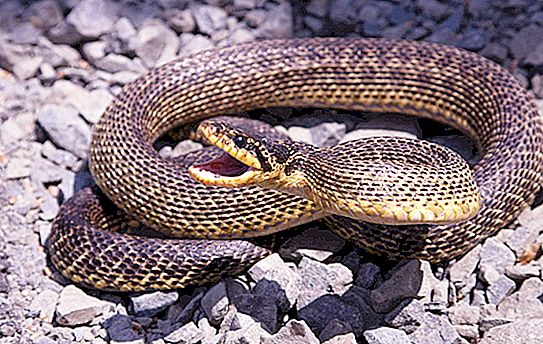
The snake is active from the second half of March - beginning of April to the end of September - early November.
External features
This is a fairly large snake - some specimens with a tail can reach two meters in length. The Sarmatian snake has a characteristic color, although representatives of the species from different parts of the range can differ quite significantly. For example, in the western regions they have more pronounced brown, almost black, or brownish-brown oval or rhombus-shaped large spots that extend along the back and merge into a zigzag strip in some areas.
The belly is covered with numerous dark spots. The tail is of moderate length. In adults, the lower body is usually monochromatic, bright yellow, although snakes with a bright orange abdomen and almost white are found.
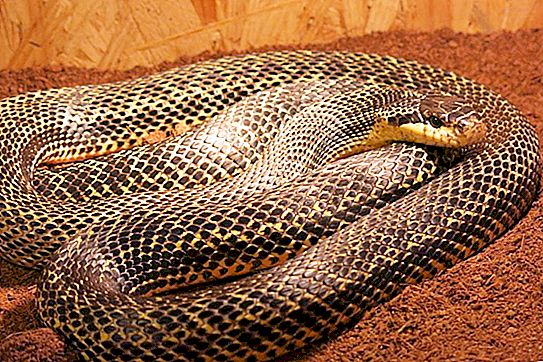
The young growth is significantly different in its color. In young individuals, the back is colored gray, with regular and clear and transverse stripes, which sometimes merge into a zigzag strip. Rows of black rounded spots are clearly visible on the sides. The abdomen is pinkish with black specks.
When young snakes reach a length of 50 centimeters, their body color changes. This usually occurs at the age of four.
Vivo lifestyle
Most often, the Sarmatian snake inhabits open landscapes. Climbing rocks and trees, it often climbs onto branches for heating or in search of food. Cracks in rocks or in the soil, rodent burrows, hollows under stones, including the ruins of buildings, are used as shelters. In anthropogenic landscapes lives in the presence of shelters.
Researchers argue that in some cases, the snake is also active at night. The Sarmatian snake has a rather bright color, which is an excellent camouflage masking an animal in characteristic biotopes. It is for this reason that when there is a danger of detection, the snake does not try to hide - it lies motionless, in the hope that the protective coloration will help it go unnoticed.
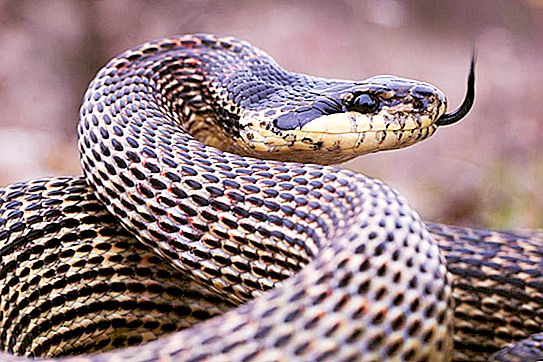
When catching this species of snake, two variants of snake behavior are noted. Sometimes she opens her mouth and hisses, after which she makes a throw towards the source of danger. The length of the throws can sometimes reach the length of the body of the snake. In the southern regions of Russia, the snake leaves wintering in April, and if the weather is warm, at the end of March. At sunrise, the snakes get out of their shelters, warm themselves up to about 10 hours, then hide and get out again at only 15 hours.
Food
Under natural conditions, the basis of the diet of the Sarmatian snake is made up of large rodents, birds, their chicks and eggs, much less often - lizards. The snake strangles its prey with the rings of the body. Like other species of the genus Elaphe, this snake has an egg saw. Swallowing eggs, the snake emits a crunch of crushed shell. True, the snake does not always use such a saw, often the snake moves eggs intact into the stomach.
At different times of the year, the taste preferences of this reptile change: in spring, it prefers to hunt birds, then switch to their eggs, and in summer and autumn, rodents make up the basis of the diet. Interestingly, the snake is able to completely refuse food for more than a month. This usually occurs before wintering or during the mating season.
Breeding
Sarmatian snake is an egg-laying snake. The female lays from 6 to 16 oval-shaped eggs, painted white. They are quite large - 55 x 23 mm. Mating occurs immediately after hibernation, most often in April. In early May, many pregnant females appear. Pregnancy lasts for two months.
Females are very caring mothers. They fold into a ring around the masonry and protect its entire incubation period. If at this time the snake is disturbed, it can attack, but more often it curls up even more densely and remains almost motionless.
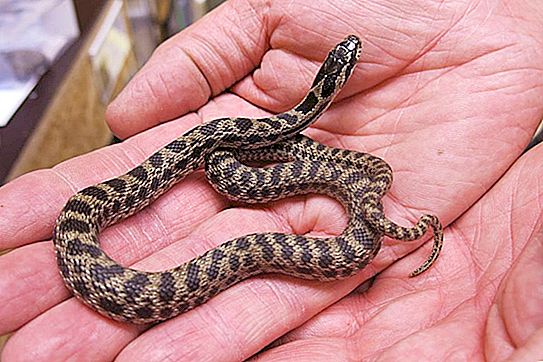
After exiting the eggs, young snakes are 26 cm long and weigh no more than 17 grams. Newborns of this species are the largest among the genus Elaphe.
The content of Sarmatian snakes
These snakes are kept in horizontal terrariums. For an adult snake, the size of the bottom of the terrarium should not be less than 70 x 40 centimeters. Young individuals are grown in separate containers, gradually increasing their size.
The soil in the terrarium is moss, coconut, leaf litter, coconut chips and paper. A prerequisite for the maintenance of this species is the presence of humidity chambers and shelters.
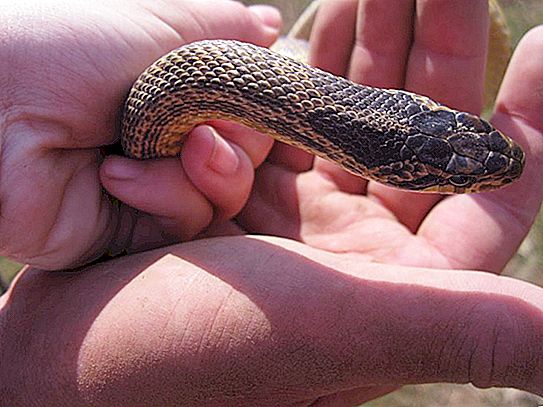
In a warm corner, the temperature is maintained up to +35 ° C, and in a cold corner - within +27 ° C. Humidity is recommended low with good ventilation. Drinking bowls will be required small, since this type of snake does not bathe in them. A source of ultraviolet radiation is not needed, but it is necessary to provide good natural lighting, since it is an important factor in stimulating snakes to mate.
Feeding
Sarmatian snakes are fed according to the following scheme: young animals - once a week, and adults - once every 10 days. As food use mice and rats, other rodents: mastomis, hamsters, gerbils. Twice a year, birds and their eggs, lizards give snakes. It is categorically not recommended to feed the pet with eggs alone - the metabolism is disturbed in snakes.




